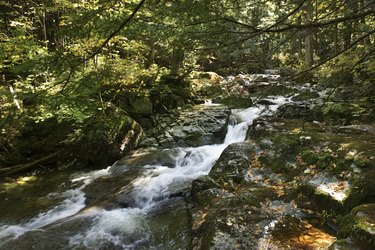It's very common for erosion to occur on the banks of streams with a sizable flow of water. Placing rocks in the bank is an effective way to slow or prevent the erosion, and it's one of the easiest techniques to put into practice.

Things You'll Need
2- To 3-Foot-Long Rocks, Flat Or Rectangular In Shape
Geotextile Material
Shovel
Wading Boots
Step 1
Determine the number of rows of rocks you need to stabilize the creek bank. In slower-moving streams, the bank is short enough that only one or two rows of rocks will be required. Larger streams, or those with more serious erosion, may require six rows or more.
Video of the Day
Step 2
Dig a slight trench for your footer rocks at the bottom of the creek bed. Dig a trench where the rock wall will begin, typically at or just below the waterline. You want to provide a solid, steady base for the layer of rocks that will serve as the base for the wall. This row is called the footer rocks.
Step 3
Lay geotextile material on the creek bank on any section that will have a wall taller than 3 feet. This material, found in most home improvement stores, will help secure the rocks to the creek bank.
Step 4
Place the footer rocks carefully into the trench you've dug. Make sure they're level and snugly seated in the trench. Ensuring the integrity of the foundation reduces the risk that the wall will collapse. If you have used geotextile material on the creek bank, tuck the bottom edge of the material into the trench and place the footer rocks on top of the material.
Step 5
Add a second row of rocks, seating them carefully one at a time on top of the layer below. It may be necessary to dig out the bank a bit to ensure that the rocks are seated properly. You can also use mud from the surrounding areas between the rocks to strengthen the wall.
Step 6
Repeat Step 5 until the required number of rows of rocks have been constructed.
Step 7
Examine the rock wall for problems. Wiggle the rocks slowly to ensure that they are properly wedged into the creek bank. Apply mud between rocks as needed to secure the wall.
Video of the Day